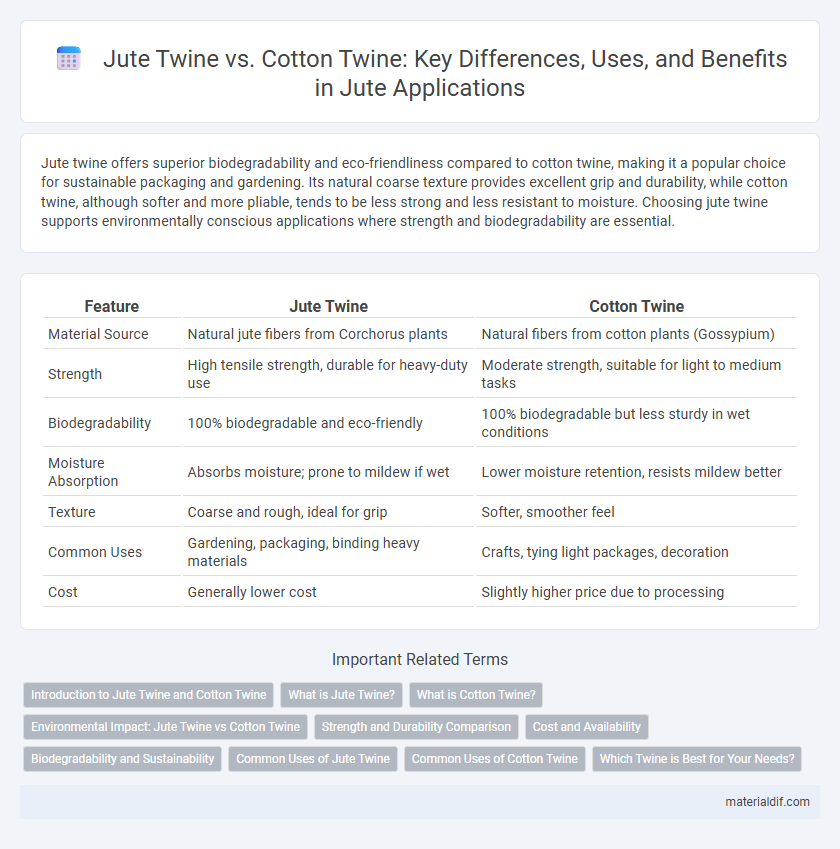Jute twine offers superior biodegradability and eco-friendliness compared to cotton twine, making it a popular choice for sustainable packaging and gardening. Its natural coarse texture provides excellent grip and durability, while cotton twine, although softer and more pliable, tends to be less strong and less resistant to moisture. Choosing jute twine supports environmentally conscious applications where strength and biodegradability are essential.
Table of Comparison
| Feature | Jute Twine | Cotton Twine |
|---|---|---|
| Material Source | Natural jute fibers from Corchorus plants | Natural fibers from cotton plants (Gossypium) |
| Strength | High tensile strength, durable for heavy-duty use | Moderate strength, suitable for light to medium tasks |
| Biodegradability | 100% biodegradable and eco-friendly | 100% biodegradable but less sturdy in wet conditions |
| Moisture Absorption | Absorbs moisture; prone to mildew if wet | Lower moisture retention, resists mildew better |
| Texture | Coarse and rough, ideal for grip | Softer, smoother feel |
| Common Uses | Gardening, packaging, binding heavy materials | Crafts, tying light packages, decoration |
| Cost | Generally lower cost | Slightly higher price due to processing |
Introduction to Jute Twine and Cotton Twine
Jute twine, made from natural jute fibers, offers exceptional strength, biodegradability, and moisture resistance, making it ideal for packaging and gardening. Cotton twine, derived from soft cotton fibers, provides excellent flexibility and a smooth texture, suitable for delicate wrapping and crafting applications. Both twines are eco-friendly options but differ in durability and texture, influencing their usage across various industries.
What is Jute Twine?
Jute twine is a natural fiber product derived from the jute plant, known for its durability, biodegradability, and eco-friendliness. It offers excellent strength and resistance to stretching, making it ideal for gardening, packaging, and crafting applications. Unlike cotton twine, jute twine boasts superior moisture resistance and a rougher texture, which enhances grip and knot-holding capabilities.
What is Cotton Twine?
Cotton twine is a strong, flexible cord made from natural cotton fibers, widely used in gardening, packaging, and crafting due to its softness and durability. It offers excellent knot retention and is biodegradable, making it an eco-friendly alternative to synthetic cords. Unlike jute twine, cotton twine is less coarse and more suitable for delicate applications requiring minimal abrasion.
Environmental Impact: Jute Twine vs Cotton Twine
Jute twine is significantly more eco-friendly than cotton twine due to its renewable sourcing and lower water requirements, as jute cultivation demands less irrigation and fewer pesticides compared to cotton farming. The biodegradability of jute twine is superior, decomposing faster and contributing less to landfill waste, unlike some cotton twines that may contain synthetic blends. Overall, jute twine offers a sustainable alternative with a reduced carbon footprint and minimal environmental impact.
Strength and Durability Comparison
Jute twine offers moderate tensile strength and is biodegradable, making it suitable for light to medium-duty tasks, whereas cotton twine generally provides higher strength and greater durability due to its tighter fiber structure. The natural fibers of jute tend to degrade faster under moisture and sunlight exposure, while cotton twine resists fraying and maintains integrity longer in outdoor applications. For projects requiring robust and long-lasting twine, cotton often outperforms jute in both strength and durability metrics.
Cost and Availability
Jute twine generally costs less than cotton twine, making it a more economical choice for bulk packaging and gardening needs. It is widely available due to the abundant cultivation of jute in countries like India and Bangladesh, ensuring a steady supply in the market. Cotton twine, while sometimes preferred for its softness, tends to be pricier and less readily available compared to jute twine.
Biodegradability and Sustainability
Jute twine offers superior biodegradability compared to cotton twine due to its natural fiber composition, breaking down more rapidly in soil without releasing harmful residues. The sustainability of jute twine is enhanced by its low water and pesticide requirements during cultivation, making it an eco-friendly alternative to cotton twine, which demands significantly higher resources and chemical inputs. Choosing jute twine supports reduced environmental impact and promotes circular economy principles in packaging and agriculture.
Common Uses of Jute Twine
Jute twine is widely used in gardening for tying plants and securing bundles due to its natural biodegradability and strong, coarse fibers. It serves as an environmentally friendly option for crafts, packaging, and agricultural applications where durability and eco-conscious materials are prioritized. Unlike cotton twine, jute twine excels in outdoor settings as it resists mildew and moisture, making it ideal for landscaping and farming tasks.
Common Uses of Cotton Twine
Cotton twine is widely used in gardening for tying plants, securing seedlings, and bundling produce due to its softness and gentle grip that prevents damage to delicate stems. It is also common in packaging, crafts, and household applications where strength and flexibility are required without abrasiveness. Unlike jute twine, cotton twine is preferred for tasks needing a cleaner, lighter appearance and minimal shedding.
Which Twine is Best for Your Needs?
Jute twine offers natural biodegradability and strength, making it ideal for gardening, packaging, and crafts that require eco-friendly materials. Cotton twine provides softer texture and higher flexibility, suitable for delicate wrapping and indoor use where gentle handling is essential. Choosing between jute and cotton twine depends on the specific application, environmental considerations, and durability requirements.
Jute Twine vs Cotton Twine Infographic

 materialdif.com
materialdif.com